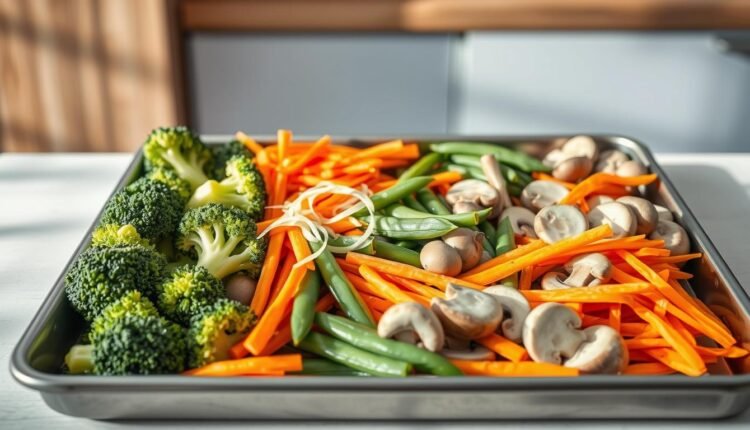Lunch Meal Prep Stir Fry With Endless Variations
Master the art of lunch meal prep stir fry with our step-by-step guide. Discover endless variations to simplify your meal planning and save time
What if you could turn 10 minutes of cooking into five days of vibrant, restaurant-quality lunches? As someone who’s burned more batch-cooked chicken than I’d care to admit, I’ve discovered a better way to approach midday meals. The secret lies in building flexible foundations rather than rigid recipes.
Through testing dozens of combinations, I’ve found that mastering stir fry meal prep creates a system that adapts to whatever your week throws at you. Whether you’re feeding picky eaters or prepping solo, this method lets you swap proteins and vegetables while maintaining that coveted crispy-tender texture. Freezer-friendly components like velveted chicken stay fresh for months, while pre-cut veggies keep their crunch all week.
The real magic happens when you combine smart batch cooking with bold flavors. A base of garlic and ginger transforms simple ingredients into something special, and customizable sauces mean you’ll never get bored. Best part? You’re not locked into specific quantities – use what you have, and watch your fridge leftovers become tomorrow’s favorite dish.
Key Takeaways
- Build meals around versatile bases that freeze beautifully
- Customize flavors while keeping prep under 10 minutes
- Store components separately for maximum freshness
Lunch Meal Prep Stir Fry
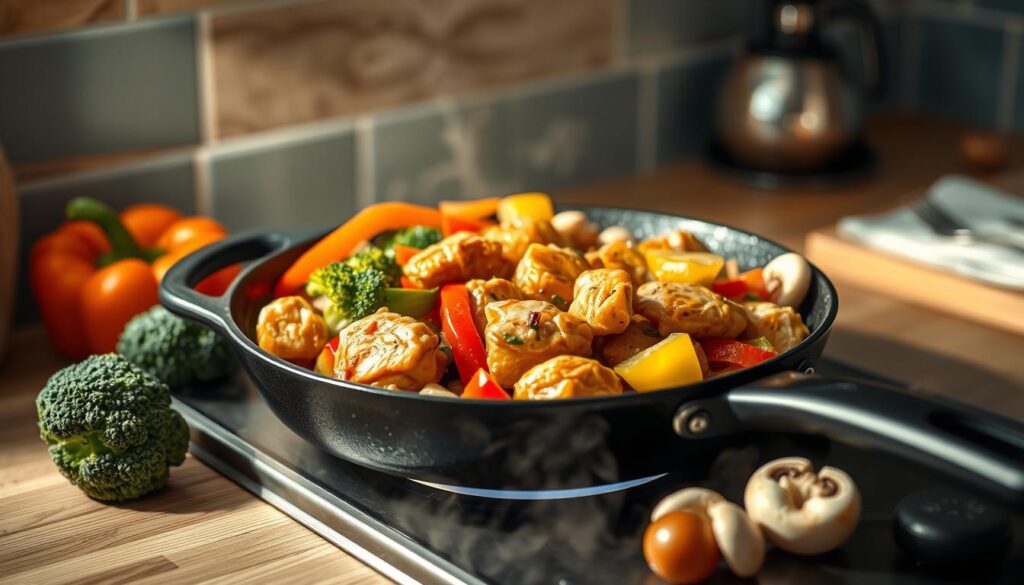
Ever wished your kitchen could handle the heavy lifting while you focus on your day? This flexible cooking method turns chaotic mornings into grab-and-go victories. At its core, it’s about building a foundation of ready-to-mix components that stay fresh all week.
Proteins like thinly sliced skinless chicken cook faster than you can scroll through emails. Pair them with crisp veggies and your choice of grains for endless combinations. The real magic lies in sauce versatility—a simple soy-based blend or zesty garlic glaze transforms basics into crave-worthy creations.
| Protein Option | Prep Time | Ideal Sauce Pairing | Storage Tip |
|---|---|---|---|
| Skinless Chicken | 8 minutes | Classic Soy Blend | Freeze raw for 3 months |
| Shrimp | 5 minutes | Garlic Ginger Glaze | Refrigerate cooked |
| Tofu | 10 minutes | Spicy Peanut Drizzle | Press & marinate |
Traditional seasonings like toasted sesame oil add depth without fuss. Pre-cooked components stored separately keep textures perfect—no soggy veggies here. I’ve found this approach works whether you’re feeding a family or just yourself.
Up next, we’ll explore ingredient selection and my favorite time-saving tools. You’ll learn how to batch-cook proteins while mastering sauce ratios that make every bite exciting. Let’s turn your fridge into a flavor station!
Gathering Ingredients and Essential Tools
Your kitchen counter becomes a flavor lab when armed with the right components. Through trial and error, I’ve learned that success starts before you even turn on the stove.
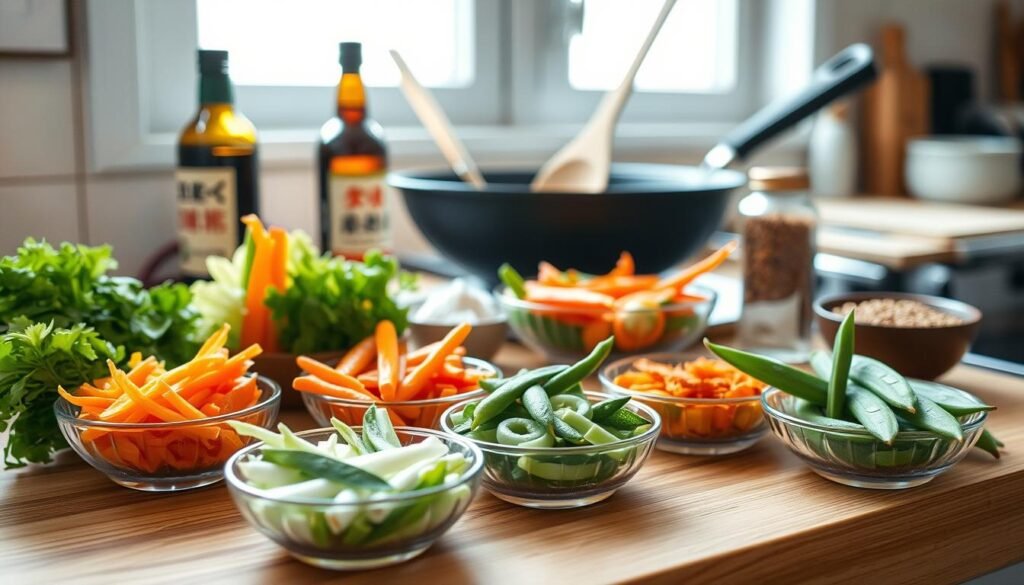
Key Ingredients Overview
Build your foundation with these essentials:
- Proteins: Thinly sliced chicken thighs (freeze raw for quick access)
- Aromatics: Fresh garlic, ginger, and scallions
- Sauces: Soy sauce, oyster sauce, and rice vinegar for balanced umami
- Textures: Cornstarch for velveting proteins, toasted sesame oil for finishing
Timing matters when you make chicken stir fry. Add chicken to a hot pan only after prepping other ingredients – this prevents overcooking. A well-crafted sauce transforms basic components into something extraordinary. My golden ratio: 3 parts savory to 1 part sweet, with acidity to brighten.
Must-Have Equipment for Meal Prep
Speed matters in high-heat cooking. These tools save precious minutes:
- Carbon steel wok or heavy skillet (retains heat better than non-stick)
- Sharp chef’s knife for quick veggie prep
- Glass containers with dividers to keep components separate
When you stir ingredients in a properly heated pan, you create that signature sizzle without steaming. Fry proteins in batches if needed – overcrowding lowers the temperature. I keep a timer nearby because 30 seconds can mean the difference between crisp-tender veggies and mushy disappointments.
With your mise en place ready, you’ll spend less time scrambling and more time savoring. Next, we’ll transform these raw ingredients into perfectly prepped building blocks.
Prepping the Chicken for Stir Fry Perfection
Transform tough chicken into restaurant-quality bites using a chef-approved trick you can master in minutes. The velveting method creates a protective layer that locks in moisture while enhancing texture – a game-changer I discovered after years of chewy chicken disappointments.

Velveting and Marination Techniques
Mix 1 tablespoon cornstarch with 2 teaspoons oil for every pound of sliced chicken. Massage this slurry into the meat until it feels slick – like applying lotion to dry skin. Let it rest 15 minutes while prepping other ingredients.
For marinades, stick to acidic components like rice vinegar or citrus juice. “Always marinate after velveting,” says Chef Ming Tsai in Simply Ming Meals. “The cornstarch barrier prevents toughness from over-marinating.” I use this combo weekly for proteins that pair perfectly with steamed rice and crisp vegetables.
Proper Freezing and Storage Methods
Arrange velveted chicken in single layers on parchment-lined sheets. Freeze until solid (about 2 hours), then transfer to labeled bags. This flash-freezing prevents clumping – no more chiseling apart frozen chunks!
Store portions with cooked rice and fresh vegetables in divided containers. The cornstarch coating maintains texture through freezing cycles, making reheated chicken taste freshly cooked. I’ve kept batches frozen for three months without quality loss.
Prepping Vegetables and Carbs for a Balanced Meal
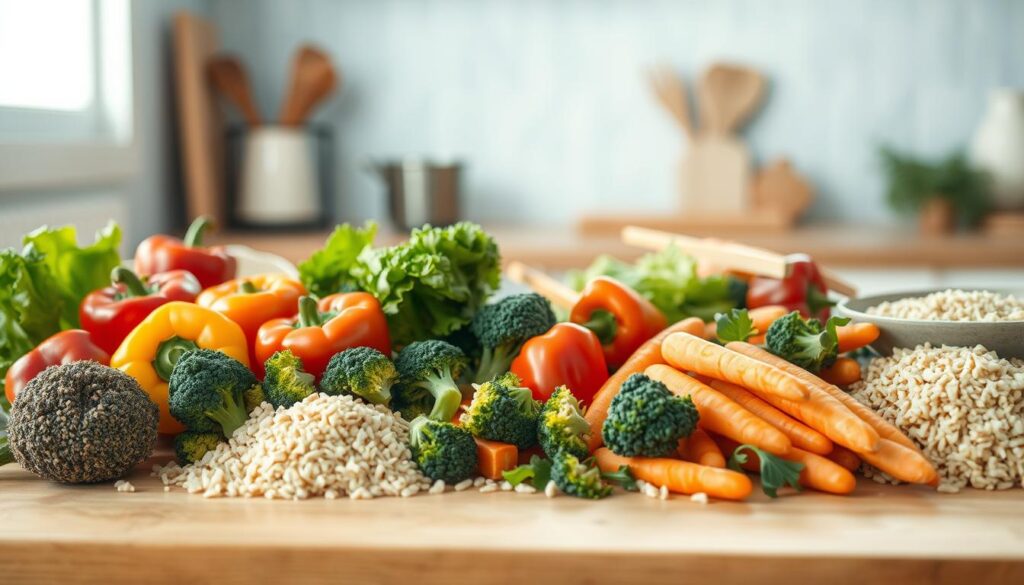
Great dishes start with smart foundations. When building your bowl, think of vegetables and grains as flavor carriers that absorb sauces while adding crunch and substance. I’ve found this balance transforms rushed midday eating into something satisfying.
Choosing Fresh vs. Frozen Veggies
Crunchy broccoli florets and crisp bell peppers shine when fresh. Look for firm stems and vibrant colors – signs of peak flavor. Frozen peas and carrots work beautifully for quick additions, especially when using pre-portioned vegetable blends.
| Vegetable | Fresh Benefits | Frozen Benefits |
|---|---|---|
| Broccoli | Crisp texture, bold flavor | Pre-cut, longer shelf life |
| Snap Peas | Sweet snap, bright color | Ready to cook, no prep |
| Bell Peppers | Juicy crunch, visual appeal | Year-round availability |
Rice and Noodle Options
Jasmine rice needs 1 cup water per 1 cup grains – measure with a coffee mug if you lack tools. For noodles, soak in warm water 10 minutes before cooking. Both options keep well refrigerated for 5 days when stored airtight.
Fresh ginger and garlic elevate every bite. Choose knobs with tight skin – they’ll grate smoothly. Store unused pieces in the freezer wrapped in foil. Grate frozen directly into your pan for instant aroma.
Creating a Customizable Stir Fry Sauce
The right sauce can turn simple ingredients into a flavor adventure. Through countless kitchen experiments, I’ve learned that mastering one versatile base unlocks endless possibilities. Let’s build a foundation that adapts to your cravings while keeping your fridge stocked with ready-to-use options.
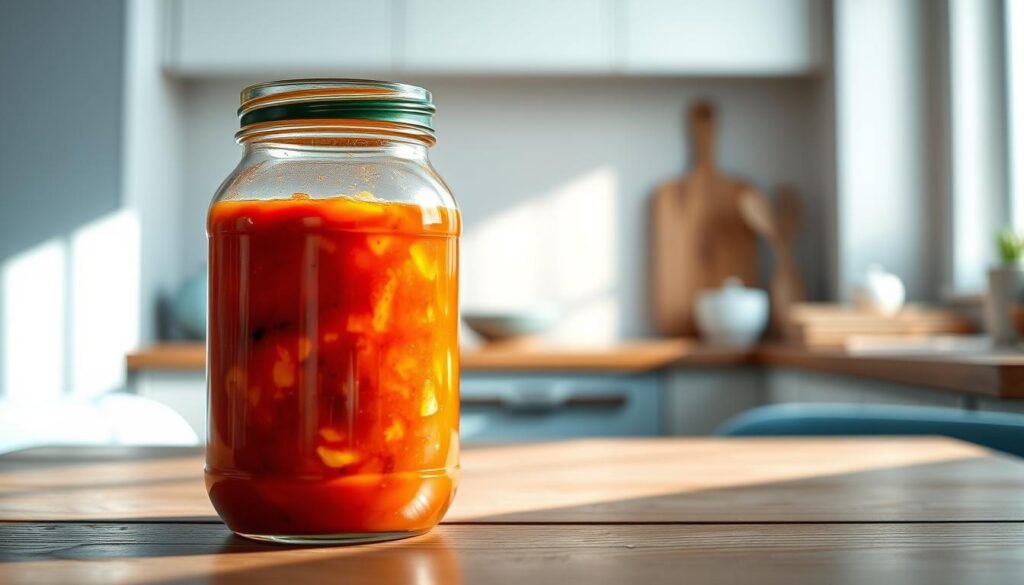
Basic Brown Sauce Blueprint
Start with this foolproof formula in your favorite mixing bowl:
- ¼ cup soy sauce (or tamari for gluten-free)
- 2 tablespoons brown sugar or honey
- 1 tablespoon rice vinegar
- 1 teaspoon minced garlic
- ½ teaspoon grated ginger
Whisk these in a bowl until the sugar dissolves. For depth, sauté diced onions in sesame oil before adding the mixture. Store in airtight containers – it keeps fresh in the fridge for 10 days.
Flavor Twists for Every Mood
Transform your base sauce your way with these simple swaps:
- Spicy Kick: Add 1 teaspoon gochujang + chili flakes
- Citrus Zing: Swap vinegar for lime juice + orange zest
- Herb Garden: Mix in chopped basil + mint
Need sweetness? Double the brown sugar. Prefer tang? Boost the vinegar. The beauty lies in adjusting ratios to match what’s in your fridge. I always make extra – it becomes my secret weapon for roasted veggies or grain bowls later in the week.
Store variations in labeled containers with dates. Glass jars prevent flavor absorption, keeping each batch tasting fresh. Remember: Great sauces balance salty, sweet, and acidic elements. Trust your palate – there’s no wrong way to make it yours.
Step-by-Step Guide to lunch meal prep stir fry
Your sizzling pan becomes a flavor canvas when you master these pro techniques. Let’s break down the process into three key phases – preparation, execution, and assembly – using components you’ve already prepped.

Cooking Techniques and Wok Mastery
Heat your wok until water droplets dance and evaporate instantly. Follow these instructions for perfect sear:
- Add 1 tbsp oil in clockwise motion to coat surfaces
- Cook proteins in 2-3 batches (1 minute per side)
- Toss veggies 30 seconds after protein removal
Keep ingredients moving like dancers in a skillet ballet. “The wok’s curve creates temperature zones,” notes Wok Weekly magazine. Use the center for quick-cook pieces and edges for gentle warming.
Flavor Layering Strategies
Build depth through timed additions:
- Sizzle aromatics first (garlic/ginger)
- Add sauce components during last 60 seconds
- Finish with fresh herbs off-heat
Need to print this workflow? Save our visual guide below. Share your favorite techniques on Pinterest – I regularly pin reader innovations with proper credit. Cast your votes in our weekly poll for featured flavor combinations!
| Stage | Time | Key Action |
|---|---|---|
| Preheating | 3 min | Test heat with water droplet |
| Protein Cook | 1-2 min | Single layer placement |
| Veggie Toss | 30 sec | Constant motion |
Remember: Each piece plays a role. Overcrowding steals the sizzle, while patience builds complexity. With practice, you’ll develop kitchen instincts that transform instructions into artistry.
Exploring Variations and Creative Add-Ins
The beauty of this dish lies in its adaptability – it’s a blank canvas for your culinary curiosity. I’ve discovered that small tweaks can make the same foundation feel new all week. Let’s break free from recipe rigidity and embrace playful experimentation.
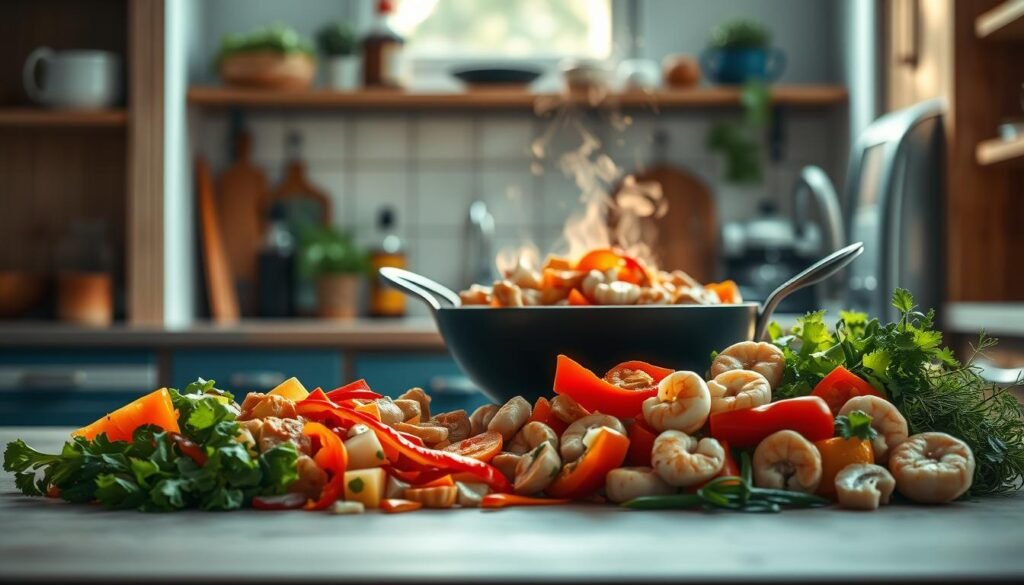
Incorporating Pickled Vegetables
My family’s favorite upgrade? Quick-pickled carrots and cucumber ribbons. Toss thinly sliced veggies with rice vinegar, sugar, and chili flakes – they’re ready in 20 minutes. These tangy toppings add brightness to rich flavors and stay crisp for five days.
Try these combinations:
- Radishes + lime zest for zing
- Red onions + star anise for warmth
- Jalapeños + honey for sweet heat
Protein and Vegetable Substitutions
Swap skinless chicken breasts for thighs on busy days – they cook faster and stay juicy. For plant-based options, marinated tofu or tempeh crisps beautifully. My Tuesday hack? Use leftover roasted veggies instead of fresh for deeper flavor.
Rotate your stir fry vegetables weekly:
- Spring: Asparagus + sugar snap peas
- Summer: Zucchini + cherry tomatoes
- Winter: Mushrooms + kale ribbons
These home-cooked tweaks prevent flavor fatigue. Store components separately, and you’ll create distinct meals all week. The dish evolves with your mood – that’s the magic of mastering variations!
Mastering these techniques turns hectic weeks into flavorful victories. Crisp bell peppers and fresh green onions add vibrant crunch, while a hint of brown sugar balances savory sauces perfectly. Remember: success lies in prepping components separately and combining them with confidence.
Keep your kitchen flexible with these simple rules. Store aromatics in oil for instant flavor boosts. Double sauce batches to transform morning routine staples into exciting meals. When textures matter most, reheat proteins and veggies separately.
Your journey to stress-free cooking starts here. Bookmark the print recipe option for quick reference, and share your favorite combos using #FlavorFreedom. Did bell pepper swaps or ginger tweaks become your signature move? Tell me in the comments – our community thrives on real-kitchen wisdom!
One last tip from my own kitchen: celebrate small wins. Burnt a batch? That’s how I discovered freezer-friendly velveted chicken. Every “oops” teaches something delicious. Now go claim your week – one sizzling skillet at a time.
Sesame Ginger Chicken Stir Fry Meal Prep
A flavorful and healthy meal prep option featuring tender chicken, crisp vegetables, and a savory sesame-ginger sauce, perfect for busy weekdays.
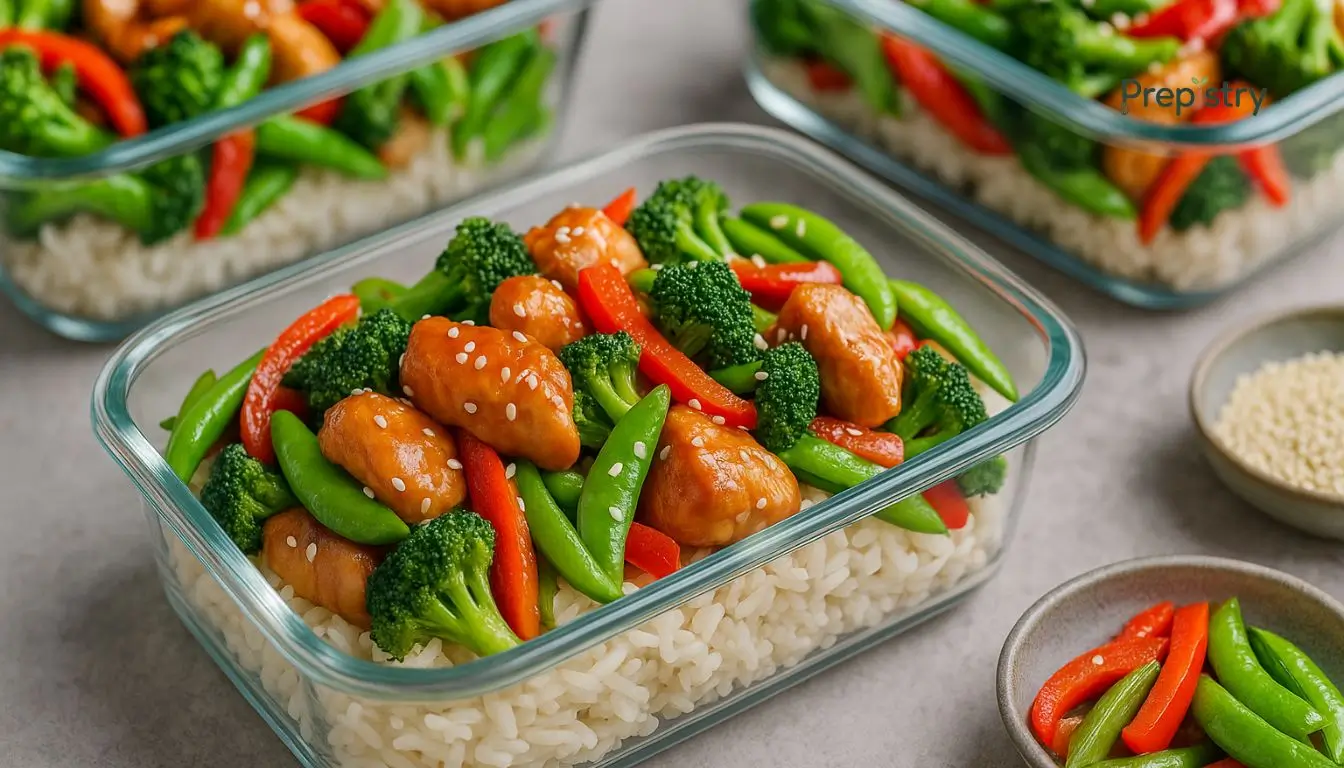
Nutrition Information
Equipment Needed
- Wok or large skillet
- Cutting board
- Chef's knife
- Mixing bowls
- Measuring spoons
- Measuring cups
- Spatula
Ingredients
-
1 lb boneless, skinless chicken breasts, sliced into thin strips
-
2 tablespoons low-sodium soy sauce
-
1 tablespoon rice vinegar
-
1 tablespoon honey
-
1 tablespoon sesame oil
-
1 tablespoon fresh ginger, grated
-
2 cloves garlic, minced
-
1 tablespoon cornstarch
-
1 tablespoon vegetable oil
-
1 cup broccoli florets
-
1 red bell pepper, sliced
-
1 cup snap peas
-
2 green onions, sliced
-
1 tablespoon sesame seeds
-
Cooked brown rice, for serving
Instructions
Recipe Video
Sesame Ginger Chicken Stir Fry Meal Prep
Learn how to make a delicious and healthy sesame ginger chicken stir fry that's perfect for meal prepping.

